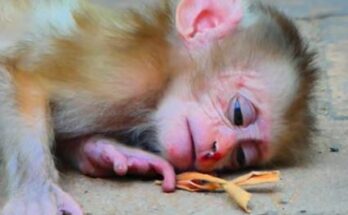In the heart of a lush, green forest, where the trees stand tall and the air hums with the chatter of wildlife, a heartwarming scene unfolds. A mother monkey, wise and experienced, watches over her tiny infant with patient eyes. The baby, still unsteady on its small limbs, clings to its mother, uncertain of the world beyond her warm embrace. But today is a special day—the day the baby monkey takes its first steps.
Mother monkeys, like many nurturing parents in the animal kingdom, play a crucial role in guiding their young through the early stages of life. Walking, an essential skill for survival, is not something the baby monkey can master overnight. It requires gentle encouragement, repeated attempts, and, above all, a sense of security that only a mother can provide.
At first, the baby hesitates, gripping its mother’s fur tightly. Its tiny fingers, still unaccustomed to independence, resist the idea of letting go. The mother, sensing this hesitation, reassures her baby with soft coos and gentle nudges. She moves a short distance away, just enough to encourage her little one to reach her, but not so far as to instill fear. This delicate balance of challenge and comfort is the essence of a mother’s teaching.
With trembling steps, the baby monkey stretches out a hand, attempting to bridge the small gap. Its legs wobble as it shifts its weight forward, testing the ground beneath. The mother watches intently, ready to catch her baby should it stumble. The first few attempts are uncertain—tiny steps followed by a quick retreat to the safety of her arms. But the mother does not give up, nor does she rush the process. She understands that learning is as much about trying as it is about failing.
Patience is key. The mother demonstrates how to move, crouching low and walking slowly, showing her baby the rhythm of balance. She makes it look effortless, yet she knows it is anything but easy for the tiny one who has never walked before. The baby mimics her movements, watching closely, trying to copy the shifting of weight from one foot to another. With each attempt, the steps become more confident, the stance more stable.
There is a moment of triumph when, after many tries, the baby monkey finally manages a few consecutive steps without falling. The mother’s eyes shine with pride as she gently strokes her baby’s fur, a silent reward for the hard work. The baby, feeling the warmth of its mother’s approval, chirps excitedly, eager to try again. Confidence builds with each success, and soon, the little one is able to move more freely, no longer clinging so tightly.
Beyond the simple act of walking, this lesson carries a deeper significance. It symbolizes trust—trust in the mother’s guidance, in one’s own abilities, and in the process of learning. The baby monkey learns not only how to walk but also how to be independent, how to face challenges, and how to persist despite setbacks. These early lessons shape the baby’s growth, equipping it with the skills necessary to navigate its environment.
The bond between mother and baby is strengthened through this experience. The baby learns that even when it stumbles, its mother is there to offer support. And the mother, in turn, finds joy in watching her child grow, knowing that each step forward is a step toward a future where the little one will one day climb, leap, and swing effortlessly through the trees.
As the sun filters through the dense canopy, casting golden rays on the forest floor, the baby monkey continues its practice. Each step it takes is a small victory, a testament to the gentle lessons of a devoted mother. And in this tender exchange, we see a reflection of the universal journey of parenthood—where love, patience, and encouragement help young ones find their footing in the vast world before them.


